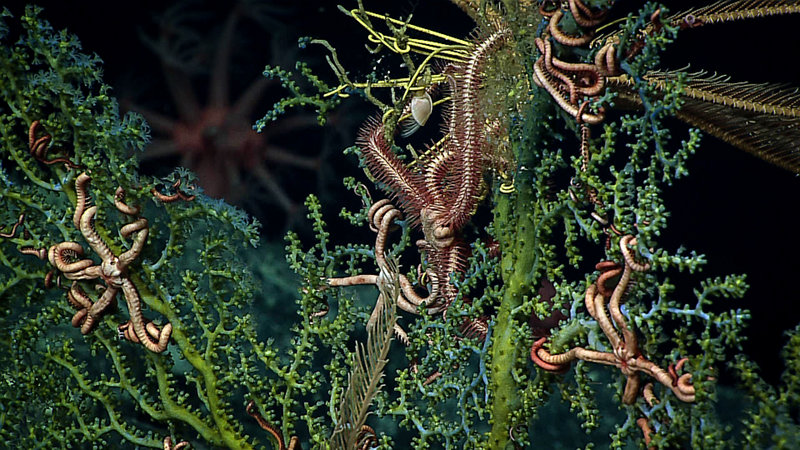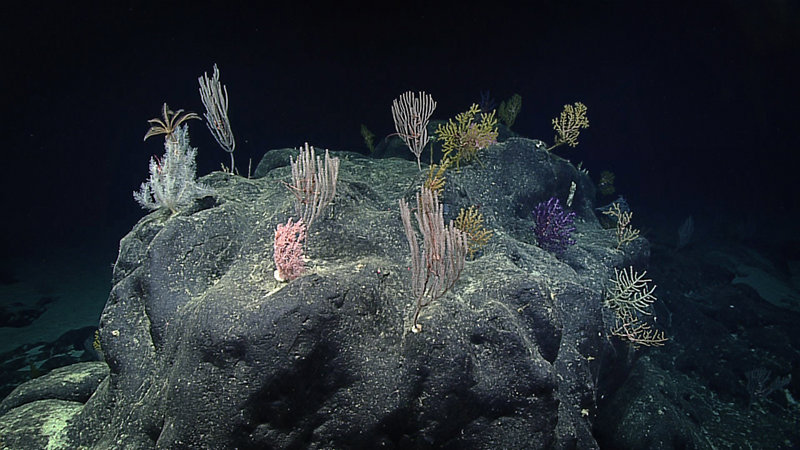
By Scott C. France - University of Louisiana at Lafayette

Brittle stars seen living in the branches of coral during exploration at 1,800 meters depth on Titov Seamount within the Pacific Remote Islands Marine National Monument, now known as Pacific Islands Heritage Marine National Monument. Image courtesy of the NOAA Office of Ocean Exploration and Research, Discovering the Deep: Exploring Remote Pacific MPAs. Download larger version (jpg, 2.0 MB).
The name of this expedition, "Mountains in the Deep," refers to seamounts, which are extinct volcanoes arising from the deep seafloor. There are an estimated ~20,000 seamounts in the Pacific Ocean and ~5,200 in the eastern central Pacific region that encompasses Hawaiʻi and American Samoa.
These undersea mountains create islands of hard rocky bottom in a surrounding expanse of mud. They are home to a different community of animals than are found in or on the soft mud. Despite the high number, fewer than 40 seamounts in this region have been explored or scientifically sampled.

High-profile rock features found on seamounts provide ideal surfaces for corals to colonize. Image courtesy of the NOAA Office of Ocean Exploration and Research, Discovering the Deep: Exploring Remote Pacific MPAs. Download larger version (jpg, 1.5 MB).
For much of the expedition, we will be exploring parts of the Pacific Remote Islands Marine National Monument (PRIMNM), now known as Pacific Islands Heritage Marine National Monument. The incorporation of "remote" into the name of the monument is both apt and relevant to this expedition. Consider the Kingman Reef and Palmyra Atoll Unit of PRIMNM, with respect to where major oceanographic research institutions – and their vessels – are found. It is approximately 1,700 kilometers (918 nautical miles) to Hawaiʻi, approximately 5,500 kilometers (3,000 nautical miles) to the Scripps Institution of Oceanography in San Diego, and approximately 5,700 kilometers (3,100 nautical miles) to New Zealand. It takes a serious commitment of time and money to bring a vessel out here to conduct research. Because of that remoteness, our knowledge of deep-sea biological communities in this region is sparse.
Much of the biological sampling completed in the remote equatorial Pacific deep sea has focused on the soft muds of the abyssal plain – the broad, more-or-less flat, muddy bottom that covers much of the deep ocean floor and from which seamounts arise. These soft, muddy habitats are relatively easier to sample than the steep, rocky seamounts.
Marine scientists use sampling devices, such as box cores that are lowered on a wire from a ship to capture and recover a chunk of the muddy seafloor. From such sampling we have some understanding of the ecology of the soft bottom-dwelling animals – many kinds of worms, crustaceans, nematodes, brittle stars, and sea cucumbers. However, these sampling devices are relatively ineffective on hard rocky bottoms. The steep and jagged topography of seamounts makes it hazardous to deploy sampling gear from a wire, as they can easily be snagged and lost in the uneven terrain. Thus, we have very little data on the seamount-dwelling animal communities in this region.

Map compiled in 2011 from ~1,000 museum records of samples of octocorals collected deeper than 50 meters (red dots). The map shows that most samples come from near the coasts of the continents or around the Hawaiian Islands and New Zealand; there is a major gap in sampling of the Central Pacific Basin. Data compiled by Eric Pante; map by Les Watling. Download image (jpg, 67 KB).
Studies of seamounts in other areas and on previous CAPSTONE expeditions suggest we will find communities dominated by sessile (attached) suspension feeders like corals and sponges that capture their food as it drifts or swims by in the water column. Where the currents are fast enough to deliver lots of food, but not so fast to dislodge them from the bottom, we may expect to see high densities and a rich diversity of sessile species.
Many other animals climb and perch on the corals and sponges, just as birds and squirrels do with trees in a forest; these "associate" species may also be capturing food from the water column or seeking shelter. Predators like fish, shrimp, and crabs may hunt among the complex three-dimensional habitat provided by the sessile community.
One of the questions scientists engaged during the dives will be pondering is the relationship of the species in these communities to species we have seen elsewhere in the Pacific. Are they the same seamount-dwelling species, suggesting broad geographic distributions across the Pacific, or will we find new species unique to the Central Pacific Basin?